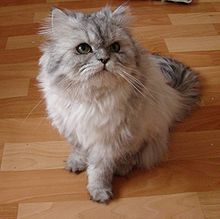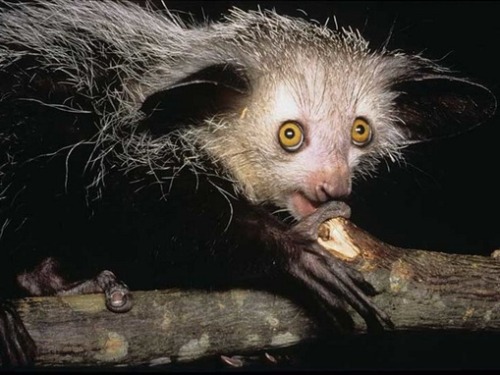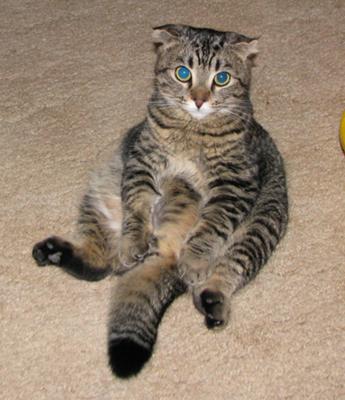The
Persian is a long-haired breed of
cat characterized by its round face and shortened muzzle. Its name refers to Persia, the former name of
Iran, where similar cats are found.
[dubious – discuss] Recognized by the
cat fancy since the late 19th century, it was developed first by the English, and then mainly by American breeders after the
Second World War. In Britain, it is called the
Longhair or
Persian Longhair. The
selective breeding carried out by breeders has allowed the development of a wide variety of coat colors, but has also led to the creation of increasingly
flat-faced Persians. Favored by fanciers, this head structure can bring with it a number of health problems. As is the case with the
Siamese breed, there have been efforts by some breeders to preserve the older type of cat, the
traditional breed, having a more pronounced muzzle, which is more popular with the general public. Hereditary
polycystic kidney disease is prevalent in the breed, affecting almost half the population in some countries.
The placid and unpretentious nature of the Persian confers a propensity for apartment living. It has been the most popular breed in the United States for many years but its popularity has seen a decline in Britain and France.
It is not clear when longhaired cats first appeared, as there are no known long-haired specimen of the
African wildcat, the ancestor of the domestic subspecies. There were claims in the 19th century that the gene responsible for long hair was introduced through hybridization with the
Pallas cat, but research in the early 20th century refutes this theory.
The first documented ancestors of the Persian were imported from
Khorasan, Persia into Italy in 1620 by
Pietro della Valle, and from Angora (now
Ankara),
Turkey into France by
Nicholas-Claude Fabri de Peiresc at around the same time. The Khorasan cats were grey coated while those from Angora were white. From France, they soon reached Britain.
[1] Longhaired cats were also imported to Europe from
Afghanistan,
Burma,
China and
Russia. Interbreeding of the various types were common especially between
Angoras and Persians.
Recent genetic research indicates that present day Persians are related not to cats from the
Near East but to cats from Western Europe. The researchers stated, "Even though the early Persian cat may have in fact originated from ancient Persia, the modern Persian cat has lost its
phylogeographical signature.
Health
Pet insurance data from Sweden puts the median lifespan of cats from the Persian group(Persians, Chinchilla, Himalayan and Exotic) at just above 12.5 years.
[24] The modern
brachycephalic Persian has a large rounded skull and shortened face and nose. This facial
conformation makes the breed prone to breathing difficulties, skin and eye problems and birthing difficulties. Anatomical abnormalities associated with brachycephalic breeds can cause
shortness of breath.
[25] Malformed
tear ducts causes
epiphora, an overflow of tears onto the face, which is common but primarily cosmetic. It can be caused by other more serious conditions though.
Entropion, the inward folding of the eyelids, causes the eyelashes to rub against the cornea, and can lead to tearing, pain, infection and cornea damage. Similarly, in upper eyelid
trichiasis or nasal fold trichiasis, eyelashes/hair from the eyelid and hair from the nose fold near the eye grow in a way which rubs against the cornea.
[26] Dystocia, an abnormal or difficult labor, is relatively common in Persians.
[27] Consequently, stillbirth rate is higher than normal, ranging from 16.1% to 22.1%, and one 1973 study puts kitten mortality rate (including stillborns) at 29.2%.
[28] A veterinary study in 2010 documented the serious health problems caused by the brachycephalic head.
[29]
As a consequence of the BBC program
Pedigree Dogs Exposed, cat breeders have too come under pressure from veterinary and animal welfare associations, with the Persian singled out as one of the breeds most affected by health problems.
[30] Animal welfare proponents have suggested changes to breed standards to prevent diseases caused by over or ultra-typing, and prohibiting the breeding of animals outside the set limits.
[31] Apart from the GCCF standard that limits high noses, TICA and FIFe standards require nostrils to be open, with FIFe stating that nostrils should allow "free and easy passage of air." Germany's Animal Welfare Act too prohibits the breeding of brachycephalic cats in which the tip of the nose is higher than the lower eyelids.
[29]
Polycystic kidney disease (PKD) which causes kidney failure in affected adult cats has an incidence rate of 36–49% in the Persian breed.
[32] Cysts develop and grow in the kidney over time, replacing kidney tissues and enlarging the kidney. Kidney failure develops later in life, at an average age of 7 years old (ranging from 3 to 10 years old). Symptoms include excessive drinking and urination, reduced appetite, weight loss and depression.
[33] The disease is
autosomal dominant and ultrasound or DNA screening to remove affected individuals from the breeding pool has allowed some lines and catteries to drastically reduce or eliminate the incidence of the disease.
[34]
Hypertrophic cardiomyopathy (HCM) is a common heart disease in all cats. It is hereditary in the
Maine Coon and
American Shorthair, and likely the Persian. The disease causes thickening of the
left heart chamber, which can in some instances lead to sudden death. It tends to affect males and mid to old-aged individuals. Reported incidence rate in Persians is 6.5%.
[35] Unlike PKD which can be detected even in very young cats, heart tests for HCM have to be done regularly in order to effective track and/or remove affected individuals and their offspring from the breeding pool.
[36]
Early onset
Progressive retinal atrophy is a degenerative eye disease with an autosomal recessive mode of inheritance in the Persian.
[37] Despite a belief among some breeders that the disease is limited to Chocolate and Himalayan lines, there is no apparent link between coat color in Persians and the development of PRA.
[38] Basal cell carcinoma is a skin cancer which shows most commonly as a growth on the head, back or upper chest. While often benign, rare cases of malignancy tends to occur in Persians.
[39] Blue smoke Persians are predisposed to
Chédiak-Higashi syndrome.
White cats, including white Persians, are prone to deafness, especially those with blue eyes.
[40] Persians are more prone to side effects of ringworm drug
Griseofulvin.
[41]
As with in dogs,
hip dysplasia affects larger breeds such as Maine Coons and Persians. But the small size of cats means that they tend not to be as affected by the condition.
[39] Persians are susceptible to
malocclusion (incorrect bite), which can affect their ability to grasp, hold and chew food.
[39] Even without the condition the flat face of the Persian can make picking up food difficult, so much so that specially shaped kibble have been created by pet food companies to cater to the Persian.
[42]
Other conditions which the Persian is predisposed to are listed below:
[43]
- Dermatological - Primary seborrhoea, Idiopathic periocular crusting, Dermatophytosis(ringworm),[44] Facial fold pyoderma, Idiopathic facial dermatitis (aka dirty face syndrome), Multiple epitrichial cysts(eyelids)
- Ocular - Coloboma, Lacrimal punctal aplasia, Corneal sequestrum, Congenital cataract
- Urinary - Calcium oxalate urolithiasis (Feline lower urinary tract disease)
- Reproductive - Cryptorchidism
- Gastrointestinal - Congenital portosystemic shunt,[45] Congenital polycystic liver disease (associated with PKD)
- Cardiovascular - Peritoneopericardial diaphragmatic hernia
- Immunological - Systemic lupus erythematosus
- Neurological - Alpha-mannosidosis
- Neoplastic - Basal cell carcinoma, Sebaceous gland tumours
Grooming
In a "lion cut", the cat's body is shaved, leaving fur on the head, legs and tip of the tail intact. It may be done to remove matted fur, reduce the need for grooming, keep the cat cool in warm weather or for aesthetic reasons.
Since Persian cats have long, thick dense fur that they cannot effectively keep clean, they need regular
grooming to prevent matting. To keep their fur in its best condition, they must be bathed regularly, dried carefully afterwards, and brushed thoroughly every day. An alternative is to shave the coat. Their eyes may require regular cleaning to prevent crust buildup and tear staining.

























